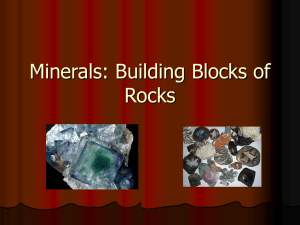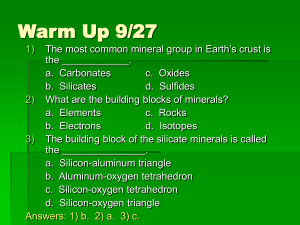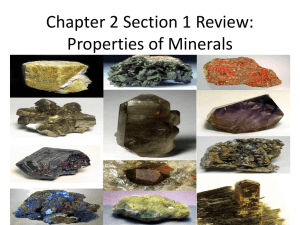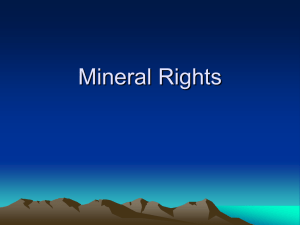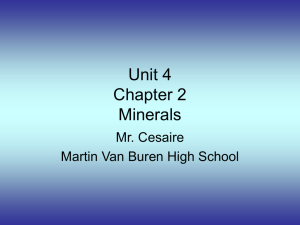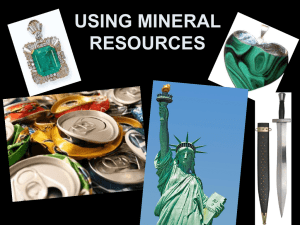Chapter 5.2 Identifying Minerals
advertisement
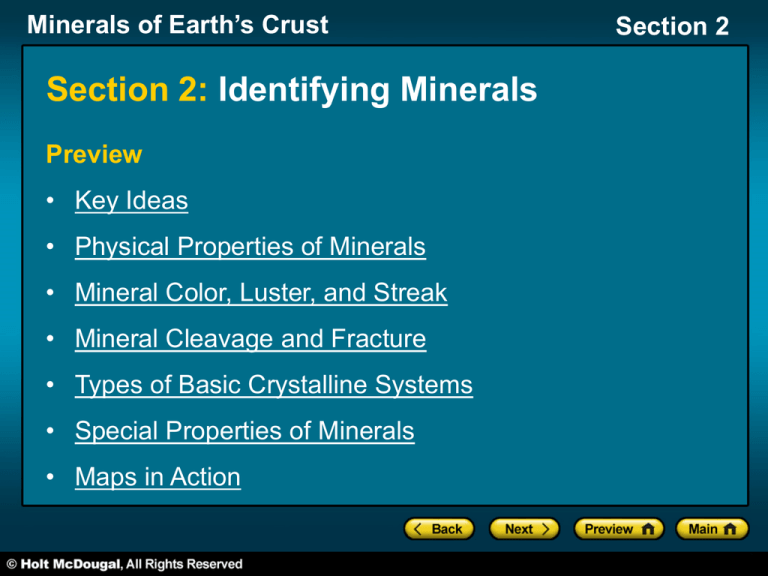
Minerals of Earth’s Crust Section 2: Identifying Minerals Preview • Key Ideas • Physical Properties of Minerals • Mineral Color, Luster, and Streak • Mineral Cleavage and Fracture • Types of Basic Crystalline Systems • Special Properties of Minerals • Maps in Action Section 2 Minerals of Earth’s Crust Section 2 Key Ideas • Describe seven physical properties that help distinguish one mineral from another. • List five special properties that may help identify certain minerals. Minerals of Earth’s Crust Section 2 Physical Properties of Minerals • mineralogist a person who examines, analyzes, and classifies minerals • Each mineral has specific properties that are the result of its chemical composition and crystalline structure. • These properties provide useful clues for identifying minerals. • Many of these properties can be identified by simply looking at a sample of the mineral or through simple tests. Minerals of Earth’s Crust Section 2 Physical Properties of Minerals, continued Color • While a mineral’s color is easy to observe, it alone is not a reliable clue for identifying a mineral sample. • The color of a mineral sample can be affected by the inclusion of impurities or by weathering processes. Streak • streak the color of a mineral in powdered form • Streak is more reliable than color for the identification of minerals. • Streak is determined by rubbing some of the mineral against an unglazed ceramic tile called a streak plate. Minerals of Earth’s Crust Section 2 Physical Properties of Minerals, continued Luster • luster the way in which a mineral reflects light • A mineral is said to have a metallic luster if the mineral reflects light as a polished metal does. • All other minerals have nonmetallic luster. • There are several types of nonmetallic luster, including glassy, waxy, pearly, brilliant, and dull or earthy. Minerals of Earth’s Crust Mineral Color, Luster, and Streak Click below to watch the Visual Concept. Section 2 Minerals of Earth’s Crust Section 2 Physical Properties of Minerals, continued Cleavage and Fracture • cleavage the tendency of a mineral to split along specific planes of weakness to form smooth, flat surfaces • fracture the manner in which a mineral breaks along either curved or irregular surfaces • Uneven or irregular fractures have rough surfaces. • Splintery or fibrous fractures look like a piece of broken wood. • Curved surfaces are conchoidal fractures . Minerals of Earth’s Crust Mineral Cleavage and Fracture Click below to watch the Visual Concept. Section 2 Minerals of Earth’s Crust Section 2 Physical Properties of Minerals, continued Hardness • The measure of the ability of a mineral to resist scratching is called hardness. Hardness does not mean “resistance to cleavage or fracture.” • The hardness of a mineral can be determined by comparing the mineral to minerals of Mohs hardness scale. • Mohs hardness scale the standard scale against which the hardness of minerals is rated • The strength of the bonds between the atoms that make up a mineral’s internal structure determines the hardness of that mineral. Minerals of Earth’s Crust Section 2 Physical Properties of Minerals, continued The diagram below shows Mohs Hardness Scale. Minerals of Earth’s Crust Section 2 Physical Properties of Minerals, continued Reading Check What determines the hardness of a mineral? The strength and geometric arrangement of the bonds between the atoms that make up a mineral’s internal structure determine the hardness of a mineral. Minerals of Earth’s Crust Section 2 Physical Properties of Minerals, continued Crystal Shape • A mineral crystal forms in one of six basic shapes. • A certain mineral always has the same general shape because the atoms that form the mineral’s crystals always combine in the same geometric pattern. • The six basic crystal systems are the isometric or cubic system, the orthorhombic system, the tetragonal system, the hexagonal system, the monoclinic system, and the triclinic system. Minerals of Earth’s Crust Section 2 Physical Properties of Minerals, continued The diagram below shows the six basic crystal systems. Minerals of Earth’s Crust Section 2 Physical Properties of Minerals, continued Density • density the ratio of the mass of a substance to the volume of the substance; commonly expressed as grams per cubic centimeter for solids and liquids and as grams per liter for gases • The density of a mineral depends on the kinds of atoms that the mineral has and on how closely the atoms are packed. Minerals of Earth’s Crust Section 2 Types of Basic Crystalline Systems Click below to watch the Visual Concept. Minerals of Earth’s Crust Section 2 Special Properties of Minerals • A few minerals have some additional, special properties that can help identify those minerals. Fluorescence and Phosphorescence • The ability to glow under ultraviolet light is called fluorescence. • Fluorescent minerals absorb ultraviolet light and then produce visible light of various colors. • The property of some minerals to glow after the ultraviolet light is turned off is called phosphorescence. Minerals of Earth’s Crust Section 2 Special Properties of Minerals, continued Chatoyancy and Asterism • In reflected light, some minerals display a silky appearance that is called chatoyancy, or the cat’s-eye effect. • A similar effect called asterism is the phenomenon in which a six-sided star appears when a mineral reflects light. Double Refraction • The property of some minerals, particularly some forms of calcite, to produce a double image of any object viewed through the mineral is called double refraction. Minerals of Earth’s Crust Section 2 Special Properties of Minerals, continued Reading Check What is the difference between chatoyancy and asterism? Chatoyancy is the silky appearance of some minerals in reflected light. Asterism is the appearance of a six-sided star when a mineral reflects light. Minerals of Earth’s Crust Section 2 Special Properties of Minerals, continued Magnetism • Minerals that are attracted to magnets display the property of magnetism. These minerals may be magnetic themselves. • In general, nonsilicate minerals that contain iron are more likely to be magnetic than silicate minerals are. Radioactivity • The property known as radioactivity results as unstable nuclei decay over time into stable nuclei by releasing particles and energy. • A Geiger counter is used to detect the released particles and, thus, to identify minerals that are radioactive. Minerals of Earth’s Crust Maps in Action Rock and Mineral Production in the United States Section 2


